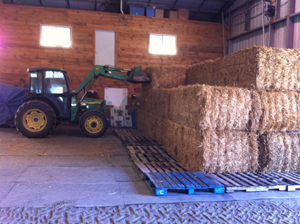Bedding change

Way back in January of 2002 we were, to my knowledge at least, one of the first alpaca farms to start using cardboard bedding on a large scale. Though I don’t have an exact number, I would say that since the construction of the Arena in the summer of 2003 we have constantly bedded down somewhere between 5,000 to 7,000 square feet between our three barns. That’s a lot of cardboard bedding! We had started using it as an experiment with our young show animals that winter after first seeing it in a trailer at Nationals the year before. As it turned out, the stuff was very effective at keeping the alpacas fleeces clean, even if it did raise an eyebrow or two at first. I still recall judge Julio Sumar coming across a piece of cardboard as he was looking at one of our animals at the 2002 NAAS, pausing and then just shaking his head as if in disbelief at what the crazy gringo farmers were keeping their alpacas on!
Granted, the cardboard had many benefits: it lasted longer than straw, it didn’t break down and form a chaff layer, and yet it was still biodegradable so that we could spread it back on our pastures along with the farm’s manure which we would compost all together. We liked the concept of the bedding so much in fact that when the original company we had used in Ohio fell on hard times several years back, we switched to a different supplier. All along the only downside to the cardboard was always the cost. None of that really mattered so much while the economy — and the alpaca market along with it — were cruising along. When good quality animals were routinely selling for 20K, we were able to view the price of the bedding as just part of the cost of doing business. That was then.
Alas, as we all know too well, the current economic picture is not nearly as rosy. So it is that almost 10 years after leaving straw behind as a our primary bedding here on the farm, we have gone back to it. Thankfully there is an ample and relatively affordable supply available courtesy of the Canadian wheat industry. We just took our first delivery of large (some 900 lb. each!) bales at the Arena the other day and over the course of the next couple of weeks we will be transitioning all of the barns from the cardboard and back to straw. While we fully realize that our fleeces — and especially those beautiful velcro-like unshorn tui fleeces on the fall crias — will look much worse next spring in comparison to years past, the cost savings over the course of the year may be as hight as 50%. That savings alone will go a long way towards covering this farm’s not inconsiderable hay bill. Once we did that math, switching back to straw just wasn’t that hard of a call to make. Our farm quite frankly faced the very real question of adapting to the current economic realities or perishing. Perishing would suck though and we’re still having fun, so we chose to adapt and move forward. Onward ho!
